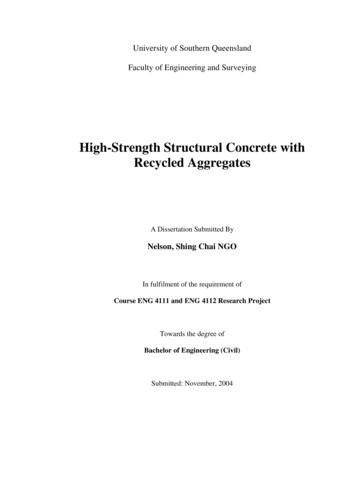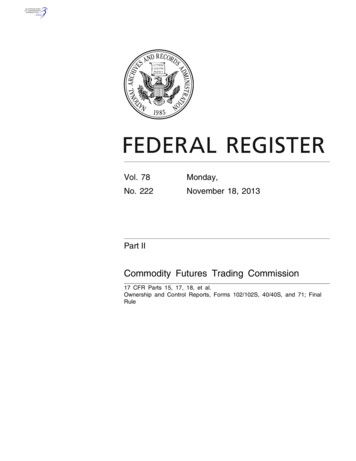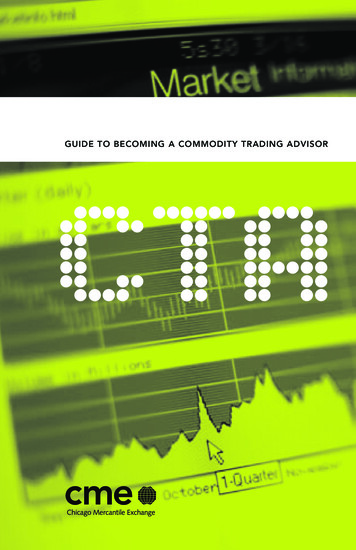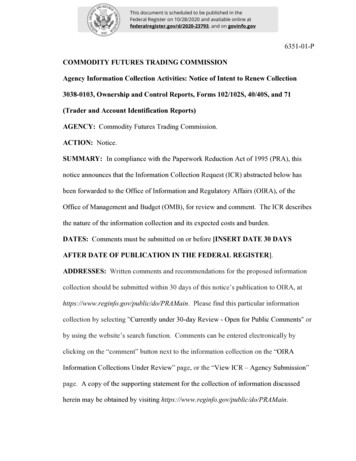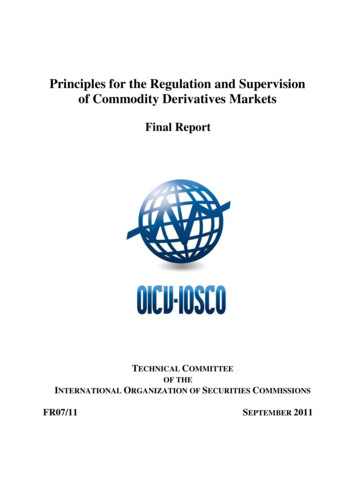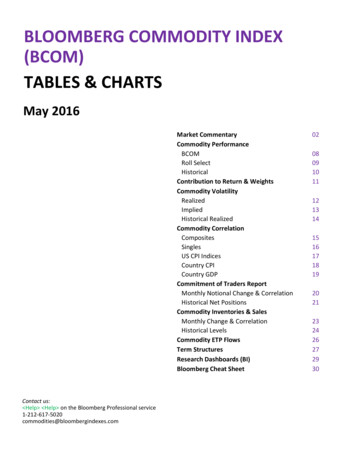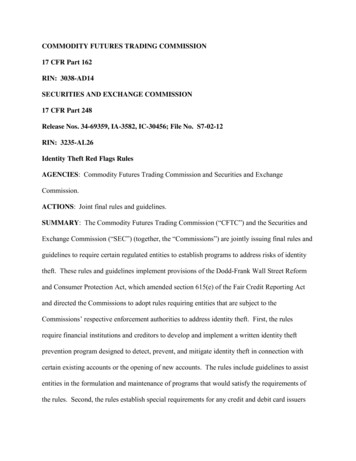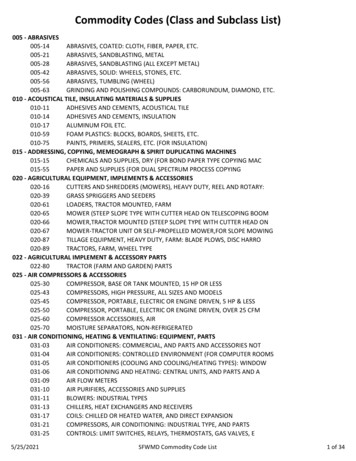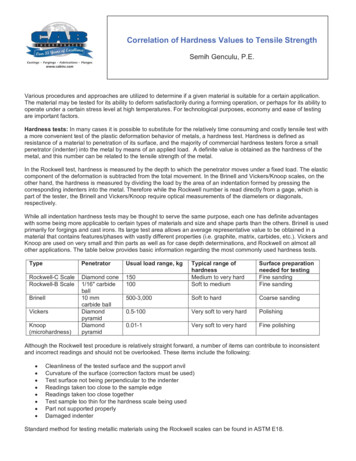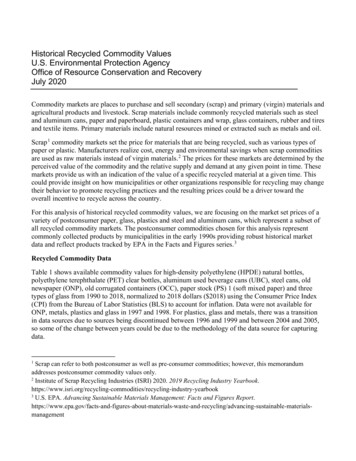
Transcription
Historical Recycled Commodity ValuesU.S. Environmental Protection AgencyOffice of Resource Conservation and RecoveryJuly 2020Commodity markets are places to purchase and sell secondary (scrap) and primary (virgin) materials andagricultural products and livestock. Scrap materials include commonly recycled materials such as steeland aluminum cans, paper and paperboard, plastic containers and wrap, glass containers, rubber and tiresand textile items. Primary materials include natural resources mined or extracted such as metals and oil.Scrap 1 commodity markets set the price for materials that are being recycled, such as various types ofpaper or plastic. Manufacturers realize cost, energy and environmental savings when scrap commoditiesare used as raw materials instead of virgin materials. 2 The prices for these markets are determined by theperceived value of the commodity and the relative supply and demand at any given point in time. Thesemarkets provide us with an indication of the value of a specific recycled material at a given time. Thiscould provide insight on how municipalities or other organizations responsible for recycling may changetheir behavior to promote recycling practices and the resulting prices could be a driver toward theoverall incentive to recycle across the country.For this analysis of historical recycled commodity values, we are focusing on the market set prices of avariety of postconsumer paper, glass, plastics and steel and aluminum cans, which represent a subset ofall recycled commodity markets. The postconsumer commodities chosen for this analysis representcommonly collected products by municipalities in the early 1990s providing robust historical marketdata and reflect products tracked by EPA in the Facts and Figures series. 3Recycled Commodity DataTable 1 shows available commodity values for high-density polyethylene (HPDE) natural bottles,polyethylene terephthalate (PET) clear bottles, aluminum used beverage cans (UBC), steel cans, oldnewspaper (ONP), old corrugated containers (OCC), paper stock (PS) 1 (soft mixed paper) and threetypes of glass from 1990 to 2018, normalized to 2018 dollars ( 2018) using the Consumer Price Index(CPI) from the Bureau of Labor Statistics (BLS) to account for inflation. Data were not available forONP, metals, plastics and glass in 1997 and 1998. For plastics, glass and metals, there was a transitionin data sources due to sources being discontinued between 1996 and 1999 and between 2004 and 2005,so some of the change between years could be due to the methodology of the data source for capturingdata.Scrap can refer to both postconsumer as well as pre-consumer commodities; however, this memorandumaddresses postconsumer commodity values only.2Institute of Scrap Recycling Industries (ISRI) 2020. 2019 Recycling Industry s/recycling-industry-yearbook3U.S. EPA. Advancing Sustainable Materials Management: Facts and Figures le-materialsmanagement1
Historical Recycled Commodity ValuesJuly 2020There has been a general downward trend in commodity values from 2010 to 2018 except HDPE andglass; all three glass types have increased in price during that time period. The average U.S. scrapcommodity values shown in Table 1 are from single source data for each year and may not reflect localor regional conditions.Table 1. Recycled Commodity Values by Year ( 2018 per ton)SoftOCCGlassGlassGlassMixedYear(11)f Paper (1)gFlinthAmberi Greenj1990 65 7 45 44 421991 72 3 20 14 91992 54 9 12 8 31993 47 8 15 12 71994 132 49 23 17 91995 211 111 27 21 141996 82 5 18 13 31997 119 131998 83 201999 348 209 956 17 20 106 37 41 40 122000 546 374 1,065 26 40 115 70 40 38 112001 366 301 929 20 26 57 28 37 35 42002 373 206 856 31 32 95 41 37 29- 72003 445 318 863 52 68 91 67 34 22- 32004 594 433 862 84 84 119 87 33 21- 22005 828 540 1,628 197 83 108 77 32 19 12006 780 361 2,057 208 71 97 68 32 19 62007 779 435 2,053 235 104 145 114 33 22 112008 786 405 1,950 225 93 120 94 36 19 102009 458 247 1,236 95 45 69 49 28 14 82010 605 453 1,694 138 83 160 98 28 14 82011 764 702 1,908 136 93 182 124 29 19 92012 664 508 1,640 134 66 136 88 31 25 122013 710 422 1,567 131 57 130 69 31 25 122014 927 414 1,619 129 54 113 59 30 24 122015 597 273 1,330 82 51 92 55 31 25 112016 597 210 1,182 34 50 99 66 31 28 142017 587 289 1,352 30 51 147 67 32 28 122018 729 309 1,432 29 30 81 6 33 28 11abaled; end user; 2005-2018 (Secondary Fibers Pricing (SFP) and Secondary Materials Pricing (SMP), 2020); 1999-2004(Waste News); 1990-1996 (Recycling Times)bbaled; end user; 2005-2018 (SFP and SMP, 2020); 1999-2004 (Waste News); 1990-1996 (Recycling Times)cloose price, end user; 2005-2018 (SFP and SMP, 2020); 1999-2004 (Waste News); 1990-1996 (Waste Age RecyclingTimes)dsorted, densified, end user; 2005-2018 (SFP and SMP, 2020); 1999-2004 (Waste News); 1970-1996 (Waste Age RecyclingTimes)emill, Free on Board (FOB) seller’s dock; 2003-2017 (SFP and SMP, 2020); 1999-2002 (Waste News); 1970-1996 (PaperRecycler) 2018 (SFP and SMP, 2020) changed to (56) Sorted Residential Papers & News (SRPN) as ONP (6) wasdiscontinued: Consists of sorted newspapers, junk mail, magazines, printing and writing papers and other acceptable papersgenerated from residential programs (such as residential household and apartment collections and drop-off centers) sorted andHDPENaturala 267 245 240 259 346 677 341PETClearb 290 218 231 240 264 618 432AluminumUBCc 1,998 1,615 1,362 1,116 1,564 2,126 1,719SteelCand 136 100 113 118 115 107 94ONP(6)e 23 29 23 28 81 163 372
Historical Recycled Commodity ValuesJuly 2020processed at a recycling facility. Material should be free of containerboard and brown grades (OCC, Kraft bags, boxboardand Kraft carrier board). Prohibitive Materials may not exceed 2%. Outthrows may not exceed 3%fmill, FOB seller’s dock; 2003-2018 (SFP and SMP, 2020); 1970-2002 (Paper Recycler)gFOB seller’s dock; 2003-2017 is soft mixed paper (1) (last year data are available) (SFP and SMP, 2020), consisting of aclean, sorted mixture of various qualities of paper not limited as to type of fiber content. Prohibitive Materials may notexceed 1%. Outthrows plus prohibitives may not exceed 5%; 1983-2002 (Pulp & Paper) and 2018 (SFP and SMP, 2020) ismixed paper (54) consisting of all paper and paperboard, sorted mixture of various qualities of paper not limited as to type offiber content. Prohibitive Materials may not exceed 2%. Outthrows plus prohibitives may not exceed 3%hdelivered; end user; 2005-2018 (SFP and SMP, 2020); 1999-2004 (Waste News); 1989-1996 (Waste Age Recycling Times)idelivered; end user; 2005-2018 (SFP and SMP, 2020); 1999-2004 (Waste News); 1989-1996 (Waste Age Recycling Times)jdelivered; end user; 2005-2018 (SFP and SMP, 2020); 1999-2004 (Waste News); 1989-1996 (Waste Age Recycling Times)Figures 1a and 1b present different visualizations of the trends in commodity prices from 1990 to 2018shown in Table 1.Figure 1a shows the indexed values by year for all recycled commodities shown in Table 1 (three glasstypes were averaged). The values are normalized to 2018 using the Consumer Price Index (CPI) fromthe Bureau of Labor Statistics (BLS). They are indexed to allow commodity values with differentmetrics, such as dollars per ton, dollars per gross ton and dollars per short ton, to be shown on the samegraph and to compare their relative rates of change. The indexed value indicates the change in value ofthe data since 1990, where one is equal to the value in 1990. For example, an indexed value of twowould mean that the commodity value for that year would be two times the 1990 value.This figure shows similar trends across all commodities for indexed values, where one is equal to thevalue in 1990. For example, all commodity values spiked in 1995, except steel cans, and dipped in 2009.Many commodities also experienced a price spike in 2000, 2007, and 2011. In contrast, the indexed linesfor glass, aluminum and steel cans appear to fluctuate less frequently. Additionally, ONP, OCC, andmixed paper all dropped in 2018.Figure 1b shows the indexed values by year for all recycled commodities, except soft mixed paper. Softmixed paper is excluded to allow for reduction of the vertical axis and expansion of the graphicaldepiction of the other commodities.3
Historical Recycled Commodity ValuesJuly 2020Figure 1a. Indexed Recycled Commodities by Year18Indexed Value (1 Value in 1990)1614121086420HDPE NaturalAluminum UBC End UserONP (6) Mill FOB Seller's DockSoft Mixed Paper (1)PET ClearSteel Can End UserOCC (11) Mill FOB Seller's DockGlassFigure 1a. Indexed Recycled Commodities by Year (excludes soft mixed paper)Indexed Value (1 Value in 1990)876543210HDPE NaturalAluminum UBC End UserONP (6) Mill FOB Seller's DockGlassPET ClearSteel Can End UserOCC (11) Mill FOB Seller's Dock4
Historical Recycled Commodity ValuesJuly 2020ReferencesPulp & Paper Global Fact & Price Book, 2003-2004. Page 128. Paperloop, Inc. 2004.Secondary Materials Pricing and Secondary Fiber Pricing. Recyclingmarkets.net (2020). DownloadedFebruary 2020. Available at http://www.recyclingmarkets.net/ (for-purchase data).1970 to 2004 historical data tabulated from weekly or monthly industry publications and averagedannually during the time periods shown. Publications included Waste Age Recycling Times, Waste News,Paper Recycler, Miller Freeman, Inc5
glass; all three glass types have increased in price during that time period. The average U.S. scrap commodity values shown in Table 1 are from single source data for each year and may not reflect local or regional conditions. Table 1. Recycled Commodity Values by Year ( 2018 per ton) Year HDPE Natural. a. PET Clear . b. Aluminum UBC. c. Steel Can. d. ONP (6) e. OCC (11) f. Soft Mixed . Paper .
